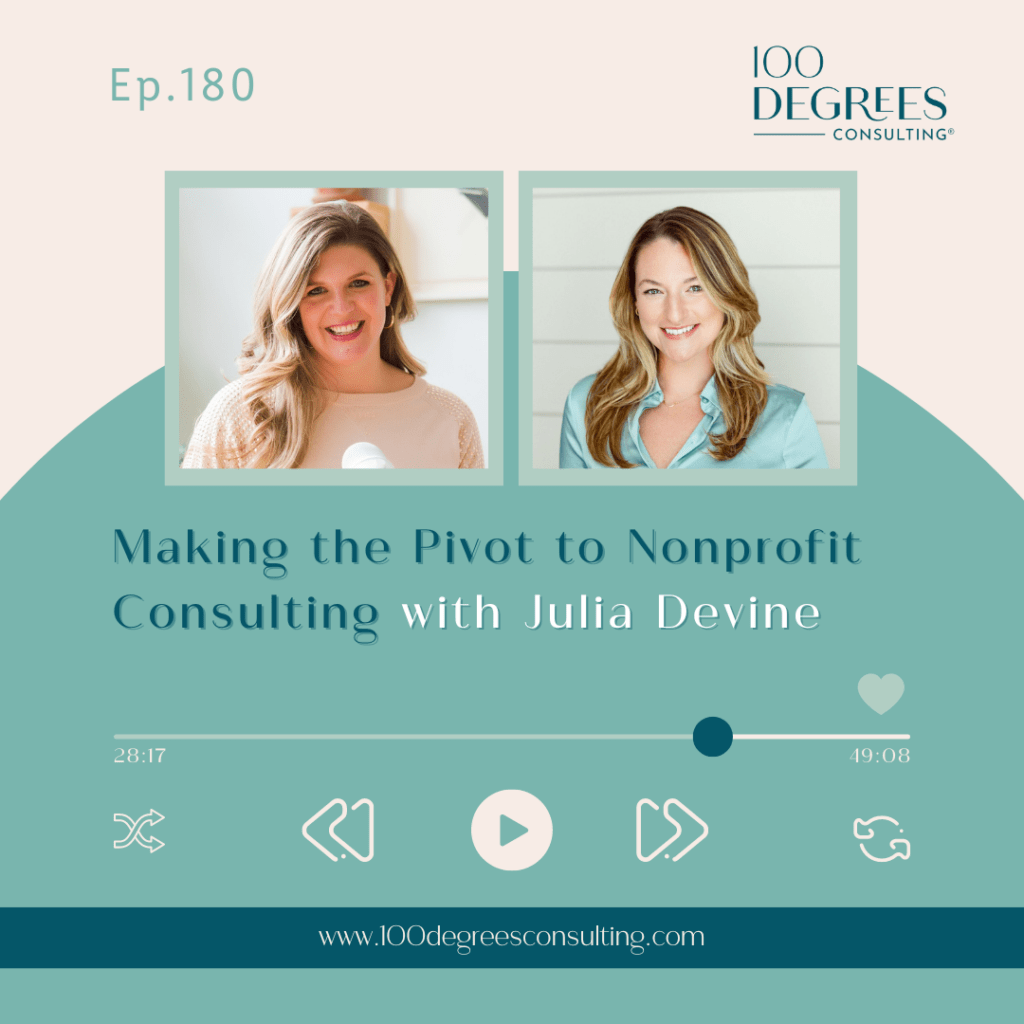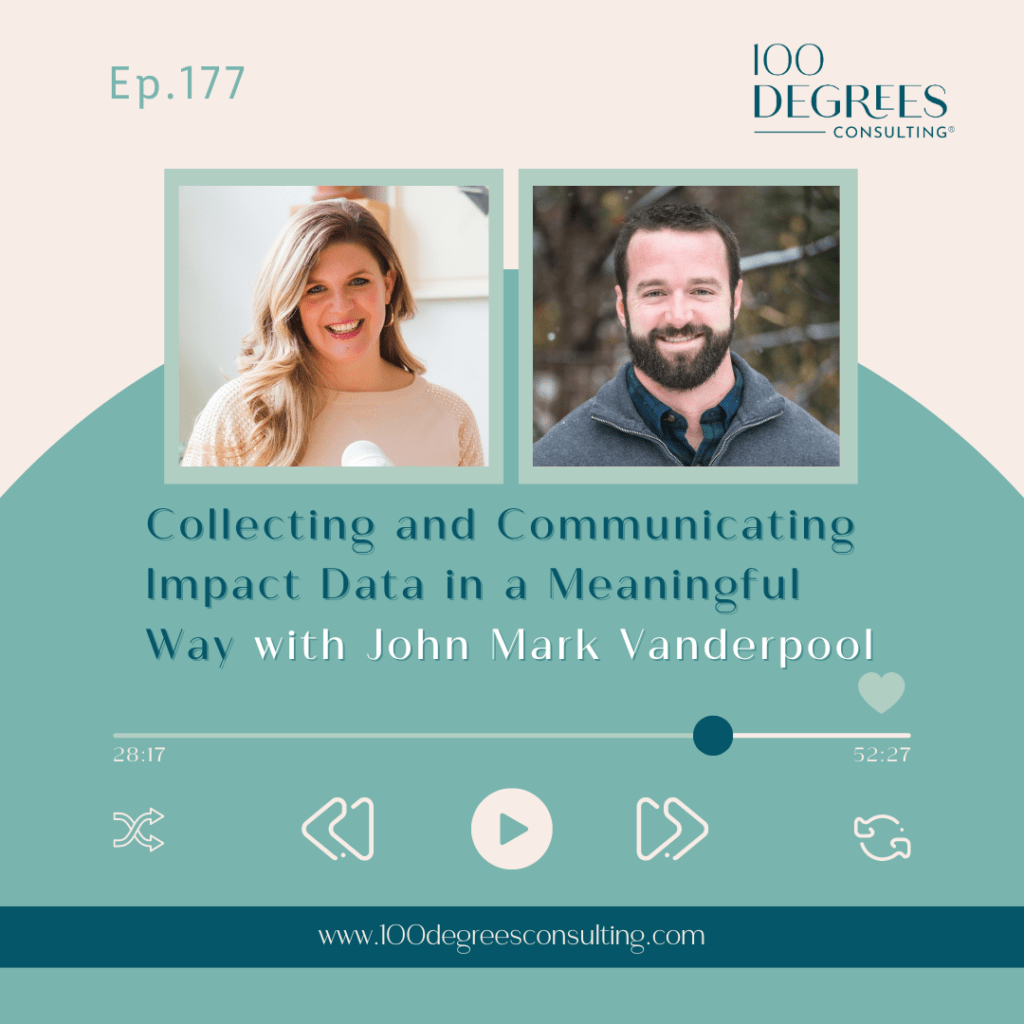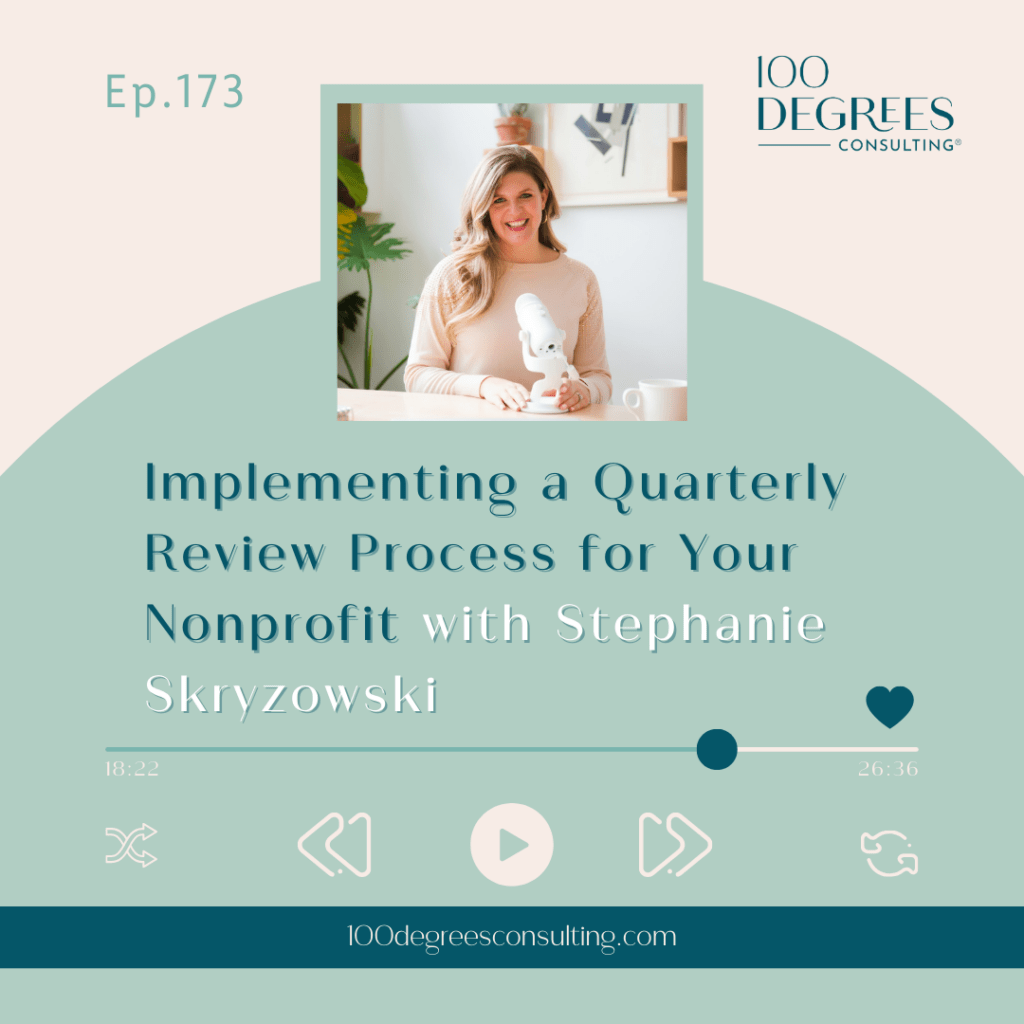Transcript Episode 149 – Using Creativity to Shake Up the Nonprofit World with Treger Strasberg on The Prosperous Nonprofit
Stephanie Skryzowski: [00:00:00] Welcome to the prosperous nonprofit, the podcast for leaders who are building financially sustainable and impactful nonprofits and changing the world. I’m Stephanie Skrzewski, a chief financial officer and founder and CEO of 100 degrees consulting. My personal mission is to empower leaders. To better understand their numbers, to grow their impact and their income.
On this show, we talk to people who are leading the nonprofit sector in new, innovative, disruptive, and entrepreneurial ways, creating organizations that fuel their lives, their hearts, and their communities. Let’s dive in.
Hey everybody, welcome back to the Prosperous Nonprofit. I’m excited to be here with you today with one of our clients, actually, who I have been really excited to meet and to chat with. So we’re talking today to [00:01:00] Trieger Strasburg, who is the founder and CEO of Humble Design. So Trieger did not set out to create a national nonprofit.
Or, to fill a hole in the continuum of care for homeless individuals, she did not plan on establishing a system that would help thousands of veterans, women, children, and families to stop the revolving door of homelessness for them. She just wanted to help a friend in need. She tells us the story of 2009 when she met a friend who was experiencing homelessness with her children.
And so, this really kicked off. Um, and I am not going to take away from the story that she tells us. I’m going to let her tell you the story in just a moment, but Humble Design has to date furnished over 3, 200 homes. for over almost 10, 000 hardworking moms, dads, kids, and veterans who are exiting homeless shelters.
And she tells us, she said this a couple of times, but families who’ve [00:02:00] benefited from the home furnishings from Humble Design have had a 99 percent success rate of remaining in their homes. So, um, the work that Humble Design is doing is incredible. Trigger as a leader is really shifting. in the nonprofit sector around fundraising, around overhead.
And she gives us a couple really good tips on how to shock your donors. Um, no, how to shock your donors and shift the conversation away from overhead and stop putting so much focus and so much emphasis on, Oh, how much of my donation is going to overhead. So she gives us a couple of things that she does with.
Conversations with donors with her thank you letters that are really impactful. So I hope you’ll listen. I know you’re going to get a lot out of this and she shares at the end, all of the places that you can find more about humble design and let me tell you, they have some incredible video content that really just showcases their [00:03:00] mission so beautifully, uh, that I think you’re definitely going to want to check out.
Okay. Without further ado, let’s go talk to Trigger.
Hey everybody. Welcome back. It’s the Prosperous Nonprofit. I am very excited and honored to have with me today on the show, Trigger Strasburg. Trigger, welcome.
Treger Strasberg: Thank you so much for having me. So
Stephanie Skryzowski: you are the founder and CEO of Humble Design, and I would love for you to tell us about your organization and the incredible work that you do.
Treger Strasberg: Oh, I’m happy to talk about it. Um, so I found an organization it’s called humble design and, um, we are based in five cities across the country. And in a nutshell, basically what we do is we furnish homes for families who are leading homeless situations. And we do that with donated goods from the community.
So we’re solving an issue right now, which is the bridge between things that [00:04:00] people need to give away and people
Stephanie Skryzowski: who really need that. I love that. And is this what you set out to do? Like, what has your journey looked like? Did you set out to create this non profit organization to do what you’re doing now?
Or like, what, what was the path that led you here?
Treger Strasberg: That’s a very funny question because no, um, I, I did not set out on a path for nonprofit. I always Felt like I wanted to do something with my life that had meaning. And I think that it’s just a common thread between humanities that we want to have purpose and meaning.
And I was in advertising and, um, I’m not trying to slight advertising because it was my bread and butter. And then, uh, my family is a creative family that came up through advertising, but I just didn’t feel, uh, fulfilled every day at my job. When I moved to Detroit, my husband took a job in advertising.
And we moved from Miami and I decided that instead of going back into the workforce, 15 years later, after my kids had grown, just to volunteer my time. [00:05:00] And I volunteered my time in a nonprofit to try and stay current with graphic design and advertising skills. And that was my entry point into the world of nonprofit.
I quickly realized the landscape, uh, of nonprofit is in desperate need for professionals. And also the particular problem set that I was trying to solve for when I met my very first homeless family was that there wasn’t anybody in the wraparound service industry that was providing furniture. So families who were leaving homeless shelters were sleeping on the floor.
So when I. Saw that whole new system. I had a front. All right. Well, I can either head down the road of nonprofit and try and, um, make this my focus, or I can leave that where it is and continue down the road advertising. And, and it was a real choice then I, I made the nonprofit choice. Yes.
Stephanie Skryzowski: Was that super outside of your comfort zone to kind of dive into this completely new venture [00:06:00] or is this something that you have done in other parts of your life?
Like, let’s just dive into the unknown and see what happens and see what I can do. So I
Treger Strasberg: like to think I’m adventuresome, but no, I didn’t know what a 501c3 was when I started the non profit. And I guess that’s. The gift that I gave myself at that moment was I didn’t know enough to know enough that it was probably a huge hill that I was about to climb.
So the naive part of me actually was fantastic at that point. Cause I was just like, yes, yes. Um, I am since, so I graduated with a graphic design and advertising degree from an art college. So no, nonprofit and like management and logistics, which is my job now was no part of that. However, as I went to the school of hard knocks and, and.
Raise this nonprofit. Um, I went back to school. I got my master’s in, uh, nonprofit management. So I think that, no, I didn’t have any idea what I was getting myself into. And I think a lot of people start nonprofits with like a great art and that naive spirit, which is actually really lovely. For what we’re [00:07:00] trying to do.
And if I had to go back and do it all over again, I would do the exact same
Stephanie Skryzowski: thing. I think you’re so like, I think you really hit on something because you’re right. If we know too much, we’re going to talk ourselves out of all the things. And I think about like when I started my business, same thing, like I knew literally nothing, but if I had known all the things that probably wouldn’t have done it because I would have been too scared and I would have easily talked myself out of taking that leap.
So I love that. And I like that you do it the same way. And I would imagine that there were things didn’t go so well along the way, but you would still do it the same. I
Treger Strasberg: mean, what, what better place to learn than real world experience. And I, and I looked at every time that we fell forward and there were many nights where I cried into my pillow.
We can talk about that. Like many nights where I’m like, it’s over. I’m done. I’m out. So, you know, I can’t do this. And it wasn’t that moment that taught me the lesson. It was the next morning. That you get up and go back and then, um, keep at it. And we call it [00:08:00] in our company, we call it keeping your head down and your umbrella open.
Um, and just plowing forward, you know?
Stephanie Skryzowski: Yeah. I love that. I feel like I’m in a little bit of that right now. And so what, um, beautiful encouragement. I appreciate that. So one thing we love to talk about on here are, you know, organizations that are doing things in new or disruptive or even entrepreneurial, creative ways.
And I haven’t seen another organization that is working to help families who are experiencing homelessness in the same way that Humble Design is doing. And so how did You know, I, you kind of talked a little bit about how the model came about, but I’d love to hear a little bit more about like the sort of creative process in here, because you are, you are a creative, I would imagine that you identify with that, but yeah, go a little bit more into the model and how you’ve really been able to change the landscape, um, through this creative model, if you will.[00:09:00]
Treger Strasberg: Yeah. So I think that I did come at it from a, uh, a designer perspective. I’m not an interior designer, but I am a graphic designer. And so the whole saga started because I was working at the nonprofit as a volunteer and I met a woman who we became friends at the front desk and and she invited me about 6 weeks into our relationship that she was in a homeless shelter with her and her 2 children and that just about blew my mind because.
She had a full time job and college degree. And it wasn’t what I, my mind understood me. So I had to really change my life perspective in that very night. And then number two, when we did finally leave the house and I thought that she was sleeping on the floor. Where, you know, her kids and her were making math with their overcoat, the brain I was in sleep.
I didn’t want to just stick with any furniture that came my way. I wanted it to be dignified, respectful because she was my friend. And so I think the overarching. [00:10:00] Uh, mission of humble design is to provide furniture, but really we’re not, we could change our model and still be providing dignity and empathy.
Furniture is just by the vehicle by which we do that. So what we do for each client where we design their homes is we design it like we could design it for an interior design client or a friend. We want to provide that empathy and dignity and say in your home environment that elevates. The client and provider experience to one of the quality.
So when When we deliver furniture, it’s not the same model that’s been done, you know, for the last 40 years, which is just drop off or furniture bank, whatever is available. It really is a process by which we meet the family on a, on a Monday. We get to know them, we talk to them, we look them in the eyes.
We don’t ask them questions about their social security or ask them about what government subsidies they’re on. We just ask them who they are and what they [00:11:00] like and what their children are like. And I think that shifts the dynamic immediately. And then when we deliver, which is just a few days later, we, we asked the family to leave.
And we bring in 10 volunteers and we design the entire home and we don’t leave anything undone. We framed family photographs, we hang artwork, we put in electronics, we make the beds, we put all of the organizational components of the closets, we fill the kitchen cabinets. And so when they come home, they have a fully functioning home that not only.
Is going to help them springboard into the next portion of their life, but it feels like it’s theirs. It feels like it’s a reflection of that. And so the difference between our program and other furniture programs is that level of empathy and dignity that immediately the family, uh, feels a sense of permanence, feels that they feel seen and respected within their community.
And the pride that is in your home is underestimated when we talk about, um, [00:12:00] recidivism back into homelessness, when you feel like you are in a temporary situation, the chance of going back into a homeless situation, according to national statistics, is around 50%. Getting out of a homeless shelter is not the last step in the process.
So when humble design comes in and we’ve done about 10, 000 individuals, almost, we find that almost 99 percent of our families don’t returnage homelessness. And it’s, it is the furniture, but it’s really the dignity and empathy behind furniture and home decor. So I like to say our mission is delivering furniture for families who are living in homeless shelters, but really our purpose is to provide empathy and dignity for those who feel unseen by society.
Stephanie Skryzowski: That’s just, uh, you know, I, like I was telling you before we started recording, I watched some videos of you and your team working with families and the emotion is so real and it’s incredible. And I mean, I think about my own experience, like when I create, you know, a [00:13:00] room in my home that feels cozy, like, and that feels like a space that I want to be in, I feel better.
I feel more motivated. I feel more inspired. And so I. Yeah. So I imagine that that trickle effect is huge. And so almost 10, 000 people. That’s incredible. Are there any particular stories or people that really stand out to you? I mean, you have 10, 000 of them. I would love to hear if there’s any, any that you can share with us.
Cause I think, yeah, what you do is just so powerful.
Treger Strasberg: Yeah, I think it changes like it definitely changes because I get to go down to the house. You know, my job now is mostly in an office, but when I really want to connect and build the mission again, I get to go down to the house. It’s a huge part of my job of being able to actually, um, see the effort that we’re making, um, On the faces of the family that come in.
So, um, most recently, um, I am, I don’t know if I, this is like a, a very, um, generous title for myself, but I’ve been a [00:14:00] motivational speaker and I travel around and speak to large groups about why empathy and dignity are changing the landscape of homelessness and how this, um, concept should be implemented in other, um, referral, uh, services.
So when I speak, I. Dawn, the motivational speaking cat. But I always felt this weird, like feeling of being an imposter, like there’s an imposter syndrome there. And I realized the other day when I was visiting a client, why that was. So we had a client who is 26 years old, she had an 11 year old son. And one of the questions that we ask at our intake form is how long have you been on health?
So I didn’t read her intake form. I had just come for the reveal and for the volunteer day. So when she came home and she started crying and she saw her sons. Um, I said to her, how long has it been since you’ve had your own space? And she’s like, never. Like, I know it feels like forever. Right. And she’s like, no, I’ve never had [00:15:00] my own home.
I’ve never had a door that locked. I’ve never not been homeless. No, and you can ask me all day about how I didn’t make payroll in 2011, but like, I don’t understand that level, um, of commitment. To overcoming obstacles. I don’t understand what that is. And so the reason I feel sometimes that I am speaking from a point of privilege, but I’m a motivational speaker is I will never be as motivational as our clients.
I will never have overcome anything even close to as interminable as what they have to climb. So she was homeless her whole life. She was raised, um, and then her son really liked the school that he was going to. And so she put her tent. Okay, Well, you, you know, the first thing that she told me that she wanted to talk to you is that she’s gone.
How would that feel [00:16:00] like? Well, She had also told me, um, that things would change. Um, That he’s going to feel attacked, and that he’s going to feel, like, he’s going to feel, you know, really stressed out, and that over it, too, because he’s gone of his But um, he embraces it.
And I think that, like, those stories, for me, have opened up my eyes that this is, um, an epidemic in this country that’s coming down, whether we like it or not, and it is not just drug addicted, mentally ill individuals who are struggling with being unhoused. This is, I mean, one in four individuals in the United States who are going to struggle with homelessness at some point in their life.
Wow.
Stephanie Skryzowski: That’s incredible to think that the The impact of the work that Humble Design is doing and the dignity [00:17:00] and the empathy and the way that you are, that the organization is combating this issue is going to have a generational impact. Like, I, I love that what you said, she said, like, he will never experience this.
I mean, that’s huge. Yeah.
Treger Strasberg: And then hopefully our impact is keeping families out of returning to homelessness and whether that is because they work harder, cheap people place because it deals like them or whether it’s because. The amount of, uh, dignity and empathy that their community provides. Then he’s a ripple effect, whatever it is, the combination.
It actually is allowing more people to be helped by an already strained system. So when we return 50 percent of people who get into housing back into a homeless situation, it, it overloads are already, um, overloaded system. I have a million ways, which I think that we can, um, bat homeless in the United States and thinking though on and on with your local [00:18:00] politician.
But the most thing that I, I hear the reflection that I hear back when I talk to people is what can I do? What can I hear the problem? I understand the problem, but I’m not president. I’m not congressman. I’m not a Senator. I’m not a council person. What can I do as a interior designer lawyer? I work in a grocery store.
I am a postman. How can I help? And so here humble has created a system by which. Not only do you get to help and come back to the houses, then you get to see one on one what your community looks like and how. You can connect with people who really need you and I think that’s rare.
Stephanie Skryzowski: And you started in Detroit and you have expanded pretty significantly.
Where else are you working now? We’re in
Treger Strasberg: Detroit, Chicago, Cleveland, Seattle, San Diego.
Stephanie Skryzowski: Wow. Are there plans for more expansion into more
Treger Strasberg: cities? I mean, listen, I would love to be in every city. Uh, I think every major city needs this program. [00:19:00] I think we should be the household name of donated furniture. I think every time you donate something, it should go to a family need rather than being resold for a program you don’t understand.
Yep. And I think that is the case. I think My dream is to grow exponentially. I have people, um, around me or making sure that we do that responsibly, because, um, I, like you said, like I fell forward into nonprofit. And now that we are, we have 51 employees or five cities. We have to be able to grow at a rate that’s sustainable.
And I think that the future is that we’re in every major market. I think for right now we’re a test case. I mean, we do, uh, in each city, we do about three homes a week. But we could, if we took it, every person who was being placed into housing, we could do a hundred families like at scale. And like, wouldn’t that be incredible?
We could actually hit scale in those cities. So short answer is I would love to be in every city. Long answer is we’re trying to figure out our strategic plan and how we’ll do that. [00:20:00] Mm hmm. Mm
Stephanie Skryzowski: hmm. Yeah, I think there’s definitely a lot of pieces at play that, you know, it’s, yes, let’s be in every city.
Easier said than done. But I think that’s incredible, the expansion that you’ve been able to do in the time that you’ve been able to do it. So to answer the question that you said, Okay. Um, somebody is listening to this podcast episode and they’re like, what can I do? This is incredible. The work that this organization is doing, but I don’t live in one of these cities.
How can I support? What can I do? Great question.
Treger Strasberg: So once a month I have hold what’s called a founder call. Um, and I do a Zoom call with people who are in other cities other than the ones that you volunteer in. And we have so many opportunities for you to A, either start it like I started it out of my garage.
And just help people. We do not. We have not cornered the market on helping people. So if you want instructions or how to or a laundry list of what you might need to take off, um, I think you would collect and then how to call social worker and find a family that’s, that [00:21:00] would be, um, in need of that service.
We’re so happy to help you walk through that. We’ve done the name hometown humble, um, for those particular cases. If you’re serious about bringing us to your city, And really want to learn about how, and, uh, you know, we have 10, 000 square foot warehouse in each city plus, um, and we recycle about nine and a half million pounds of furniture per year.
So it is a large, um, logistics operation to get going in the city, but we have a plan for it. So if you’re really serious about bringing us to the city, and then we can talk you through like what it would take and, and how that. Uh, you know, uh, evolves and then eventually I find the city and, and, and meet everybody.
So I would suggest that everybody’s listening, uh, either come to the founder meeting and sign up for the founder meeting at humble design. org or listen, we can’t survive without donations. So if you want to see a one to one. Result for like what you’re getting, especially around the holidays. [00:22:00] We spend every dollar on programming.
I mean, it was just a logistics, um, uh, acrobatics of how to get all this furniture down to the families. And it really does make a difference. So we stored every dollar really
Stephanie Skryzowski: carefully. I love, I like wrote this down. We have not cornered the market on helping people. I love that because I feel like sometimes in the nonprofit space, there is like this little bit of competitiveness because it feels like funding is scarce and you know, I don’t know that I have definitely felt a bit of a competitiveness in the nonprofit sector before and similar, um, you know, when people are working in similar industries.
So I love we’ve not cornered the market on helping people. So good.
Treger Strasberg: We’re going to have an open source to helping others have a start at Humble, so it’s all available to you.
Stephanie Skryzowski: I love that.
Hey there, amazing listeners. I hope you’re enjoying another fantastic episode of The Prosperous Nonprofit. [00:23:00] Before we dive back in, I have a quick favor to ask. That’s right. If you are getting value, knowledge, encouragement, or even just good vibes from our show, please share The Prosperous Nonprofit. With a friend or colleague who you think would love it as much as you do.
It’s like passing along a good book or recommending your favorite local coffee spot. Please take a quick second to hit that share button, send a link, or even give a shout out on social media. Your support means the world to me. Thank you for being awesome. Thank you for being here. And now back to the show.
Putting on my business owner hat. I love the fact that you essentially have like an SOP, a standard operating procedure for like, here’s how we open in a new market. Like this is the process. Here are our needs. This is what you need to do. I love that because that is scale. Like that’s what’s going to, um, allow you to scale and allow others to participate in the mission and to really tap into as many [00:24:00] markets as you can.
So I think that’s brilliant. And I think that a lot of. Organizations aren’t like thinking proactively like that. We kind of are reinventing the wheel a lot. So I love that you’ve got that sort of SOP in place. Well,
Treger Strasberg: I think that a lot of nonprofits do like a wide range. In fact, when they, their mission creeps, like it’s large, we’re so laser focused on what we do.
There are a lot of moving parts to moving a hospital furniture three times a week in each city. Yes. And there’s volunteers that we need to manage. We are in 10 years from now, what you ask, if you ask us what we do, you will be doing the exact same thing that we’re doing now. Unless, of course we solve the problem of publicist and then be outta business, which that’s the goal.
Stephanie Skryzowski: Yeah. . That’s the goal. It’s so true. It’s so true. I feel like a lot of organizations sort of follow the money. Um, and if a funder is like, Oh, I’m willing to fund part of this, but then you also have to do this other thing over here. We’re like, Oh, sure. That sounds good. Cause it’s money, but not all [00:25:00] money is money that we want.
If it’s distracting from, you know, from our main goal. And also the people that are
Treger Strasberg: attracted to nonprofit work have a big part, right? You’re not making, you’re not in nonprofits to make a buck, right? Um, so you’re here because of the heart. And then you see, once you’re in somebody’s space. You see the need and the need is greater.
There’s need for food and security. When we go into someone’s face, there’s need for educational items. There’s need for cars. There’s need for transportation. There’s need for excess funds for rent. So we could be dragged into markets because our hearts hold up. But I don’t think that would, um, my philosophy is that if we each take one small piece of the puzzle.
We’ll be much better off than trying to do the puzzle well. So I’m going to do my part really well and our part and, and, and, and do my part of the puzzle and hope that there are other people out there that are going to do their part of the puzzle really well, too. I love
Stephanie Skryzowski: that. Yeah. I like that a lot. I was going to ask, what’s inspiring you right [00:26:00] now, either in your organization, in the nonprofit sector, in the world, what is lighting you up right now?
Um, Yeah.
Treger Strasberg: It’s not like in this exact second, it’s kind of been like the last couple of years is the Dan Plata, um, view of a nonprofit fundraising and changing the narrative behind fundraising to one of, well, we’re trying to solve the world problems, nonprofits are trying to solve the world problems.
We’ve become a safety net where we probably shouldn’t have, because the government has, um, removed a lot of the safety nets. So we’re trying to pick up the slack and. If you want the world’s problems to be solved, you kind of have to invest. And so you want to draw the most important and smart and, uh, studied individuals to these huge problems.
And so in this community of nonprofit, it’s often looked at as a very poor taste to spend money on your employees. And, um, we’re supposed to do everything out of the kindness of our heart. And it’s tacky when you pay somebody a lot of [00:27:00] money to do something. But in doing that, we’re creating a system by which we get a lot of people who are drawn with their heart to nonprofit and are expected to give up a decent wage to do that.
And I think that’s the wrong approach. Yeah,
Stephanie Skryzowski: I agree. And I just recently watched Dan Pallotta’s TED Talk again, like three times in a row, because I’m like frantically taking notes through it so I can process. But I think his point that was so interesting, well, for me, of course, was the numbers, where he’s like, yeah, we can.
Spend, you know, whatever, 50% of our money on fundraising, and then we’re gonna be able to raise like $40 million, or we can spend this tiny percent and only raise a tiny percent. And so what, does this actually make sense? Do these numbers make sense? They really don’t. Um, and so, yeah, I think that’s huge.
And to anyone listening, if you’ve not watched Dan Pilates, Ted Talk, um, highly recommend. Have you watched his documentary on, I, I don’t know if it’s on Netflix or where it’s un charitable. I’ve not watched [00:28:00] that yet.
Treger Strasberg: Yeah, I, I’m kind of a, I read a book about his book and like, I’m kind of a freak about it.
He has changed the way that I speak to my board. He’s changed the way that I write my things. Like if somebody donates. And money to the organization. We as nonprofits are usually like, like you said, we all like, Oh my gosh, thank you so much. How can I store this appropriately? What would you like in return for your money?
How do you want to be represented? And we go and we have this posture back and forth of like, thank you so much. Well, I have taken on the, the new, um, life outlook of saying you’re welcome. Like I’ve put my blood, sweat and tears into starting this organization. So you can go and. Go to work and have a life and drive your kids to school and know that when you give to my organization, I am stewarding it with care for your community.
So you’re welcome. So I don’t say that in those blunt terms, but like I want to say when I write my thank you notes It’s like [00:29:00] I’m so glad that you found our mission that our mission resonates with you so much that you’ve invested this money in your community. And, um, and it is, it’s a big change. It’s a big change in communication.
So anybody who’s a nonprofit, I tried to get them to make this change, except we all do it and we all start talking this way, that can make a big difference in the way that people view charitable giving. Absolutely.
Stephanie Skryzowski: I love that shift because that is something that everybody can do. Literally, everyone listening, I’m sure, is acknowledging their donors and speaking to their donors and by just making that shift in the way that you’re speaking, I think you’re right.
Like, it could change the sector. It needs to, the sector needs to change. Um, and so this one little shift could be part of that. I think that’s so powerful. Okay. Need to add that documentary to my list of things to watch. It’s so good. Yeah, yeah, that’s, yeah, it’s, that’s huge. And, you know, obviously, like where, oh, I’m always trying to shift the conversation [00:30:00] when I’m teaching about financial management away from overhead and like, oh, what’s a good percentage?
What’s a bad percentage? Where should we aim? And I’m like, okay, well, I’m going to tell you what charity navigator is going to rate you on. But that is not the end all be all. This is not what we should be focusing on. You need to do it. Spends the money in the way that’s going to help you have the greatest impact.
And if that means you need to buy new computers for your staff, because they’re using, you know, 10 year old ones that are broken and slow, then that’s what you need to do, then that’s okay. But, you know, at the end of the day, we’re still sort of like governed by this archaic system that feels frustrating because our minds are sort of living in this one world yet.
Our financial statements are being judged in this other it’s. It’s
Treger Strasberg: pretty navigator and, and, and those guides are, have a, have played a big part in that, right? So, uh, for those of you listening who don’t know, like you get a poor rating if you spend a lot on overhead, which means overhead, let’s just be clear, overhead is your voice, right?
So I have, I have people who ask me how much of my donation is going to [00:31:00] program and how much of my donation is going to overhead. And I go, well, okay, well, what is And they said, well, your office staff. I pull, okay, so here’s my office staff. This is David. David is our warehouse manager in Chicago. David is a, an amazing human being who stewards our mission with care.
And he’s been with us for a very long time. David is overhead. David should make a living wage, right? David should be able to pay his bills, and his family should have food on the table, right? And everyone’s like, of course. And I’m like, okay, well, in Chicago, what do you think that means? What do you think that salary should be?
And whatever it is they guess, it’s always over what we’re paying. It’s always over, and I’m like, okay. So let’s be clear. David is, oh, sorry, David, if you’re listening. David is over, and I don’t, I don’t think that you would want David. To not be, have a, have a dignified life. So it’s shifting the conversation to talking about obr, to talking about people and putting names to that, especially if you’re a smaller organization.
When somebody says like, what’s going to [00:32:00] obr? And you go, oh, Sandy in the front office, you know? Right. That is aship like, oh, okay, yeah, I understand now. And that that’s a way that I can understand it. If you’re talking to a corporation, a large corporation that just has to produce a CSR report and then wants to know what’s going to overhead, that’s different.
But when you’re talking to individual donors, I think that that’s a really important conversation.
Stephanie Skryzowski: I love that. I’m sure, like, as you’ve had those conversations, you’ve definitely, I could imagine you’ve gotten people like, oh, oh, oh, like, oh, should I not have asked that? Like, no, you shouldn’t have asked that.
No.
Treger Strasberg: I love having the conversation because it’ll, they’ll never ask that same question again. They’ll never walk into another nonprofit and be like, how much is my, My, uh, my dollar is going to, to Obreht. They’ll never have, cause it’s embarrassing. Yeah. I’m like, Oh, you mean this person sitting next to me who’s, you know, working at the organization.
Yeah,
Stephanie Skryzowski: this human being that needs to eat and have a place to live. Yeah, them. Okay, if anybody listening does this, I want to hear about it because I think this [00:33:00] is huge. Again, little shift and you need to have like kind of, I feel like Could be slightly awkward conversation and because you’re going to take people aback for sure.
But if anyone does this, I number one, I hope you do. Number two, I want to hear about it because this is a very powerful shift and I love that you do this. So good.
Treger Strasberg: Thank you. Awesome.
Stephanie Skryzowski: Well, the last question I have for you today is what does a prosperous nonprofit look like to you?
Treger Strasberg: It’s a great question. So I love that we’ve served 10, 000 people and I love that we have so many stories and videos of kids crying at the sight of their first bed and how like the ripple effect will never really understand.
And I think that is a big part of my legacy of who I am and how I want to be remembered. However, when I walk into a warehouse in one of my cities and it is a bus and there’s volunteers, staff members, there’s people dropping off furniture and there’s people learning about the organization for the first time, the phone is ringing.
I almost burst into tears. [00:34:00] It is, um, obviously I burst into tears all the time. Clearly I’m a nonprofit, but, um, but I really do find that the most emotional part, and it’s not because so much of what I, that’s going to translate into more families that we’re going to help. It’s because I feel a deep sense of peace that the world is going to be okay.
But there’s so many people who want to help and so many good people. And then I feel like when we turn on the TV and we’re inundated with How awful the world is. I feel like the proofs that that is absolutely not the case is when you stop and look around you at your own circle. And my circle happens to be thousands of volunteers who are drawn to this mission.
And it gives me so much peace when I lay my head down on the pillow at night, that if God forbid I get hit by a bus tomorrow, there will be an army of people pick up where I’m left off. Um, and who just want to do good for the world. And that’s my truth. Um, and that’s [00:35:00] my proof that the world’s going to be okay.
Hmm. That is beautiful. It’s incredible. So that’s what I, that’s what I think a robust and successful organization is, is if you draw people to your mission and their path, they’re equally or more passionate about the mission than you are. Bravo. Sail off into the sunset. I mean, the best thing you can do is to train our people to do a better job than you did.
Stephanie Skryzowski: A hundred percent. Yeah. Yeah. And that’s the legacy that I think as leaders, we all want to leave. It’s like we started the ball rolling and you know, now I have built a community around us that are ready to carry that ball further than we ever could. That’s
Treger Strasberg: why founder syndrome is a real thing and it’s really dangerous.
Um, and I try and avoid it. But I would love nothing more in this whole world for everyone to have as much passion and drive for the mission as, as I do. And that is what I found. I found a collective of people who feel the same way that I do, that they just want to help. Mm hmm.
Stephanie Skryzowski: That is definitely prosperous.
I would say that is a prosperous [00:36:00] nonprofit. Fantastic. Well, listen, Humble Design has no shortage of video content that we can really experience your mission. And I’ve like binged a little bit. I was telling you before we started the call that Every month my team has a, you know, a monthly team call and we do a client spotlight where we highlight one of our incredible clients and share with the rest of the team a little bit about their mission.
So our whole team got to watch, um, one of your short videos, but I would love for you to tell us where could we learn about Humble Design? Where can we watch some of these incredible stories of the clients that you work with? And if we want to learn more to support financially or otherwise. Tell us where we find all the things, please.
Well, sure. So our website
Treger Strasberg: is humble design. org. Um, which is a super easy way to look around and see, um, a lot of the families that we’ve serviced, but our social media accounts, so we have. Six social media accounts on most of the majority of the popular platforms. [00:37:00] Um, Facebook and Instagram tell our, uh, stories families each week.
So we get, just so everybody knows out there, we get permission from our families to tell their story and if they don’t feel comfortable and they don’t want to tell a story, we absolutely do not. video them or photograph them. So every story that you see on our social media is a family that wants to tell their story.
And we video them coming home, which is like the best part. And they cry and we cry and we yell, welcome home. And we hug and they get to see their bed and all the volunteers. I get to take, um, You know, moment just to look at the family that they, that they’ve helped for the day. So it’s a really lovely, emotional video.
So our social media is the best way to see those. Also, um, you and my mom both watch the TV show. So thank you for that. Um, but we did have a TV show. We had 26 episodes. I was on with CW and if you go right now, it’s been syndicated by BYU. So it’s on the website. Uh, you can click at the top. It’s called welcome home TV.
Um, and it will take you to the [00:38:00] BYU TV website where all of our episodes are there. I would bring a box of tissues with you because although it was children’s programming, it is just a very heartwarming show. And I cried every week. So you can watch me, um, have, uh, what my husband calls the peach pit of a chin where I, right before I cry.
So I, um, I love those videos and I love watching them and as many times as I’ve watched some of the more popular videos, we had one with like 20 million views of a little boy who saw his bed for the first time at Christmas, um, and cried. As many times as I’ve watched them, I still cry and I, and I think it’s just a, the human condition to want to offer to eat.
And that’s exactly what you see in those videos is a huge amount of won’t eat. Mm hmm. Oh, and donate. Oh, please. And donate and go on our website and donate because as much as I sound like I know what I’m doing in fundraising clearly every year we’re fighting to make sure that [00:39:00] we pay a living wage and keep our staff and the five cities around.
So 51 employees and 10, 000 individuals in your money will be shorted. Yes.
Stephanie Skryzowski: And I think, you know, one thing I’ve learned from another nonprofit friend is like, yeah, maybe we, maybe we’ve got the money to fill our budget for this year, but we are trying to solve a very big problem. And so just cause like, yeah, sure.
We’ve, we’ve raised the money that we need to this year. We are trying to solve a very big problem. And so the need for funds is endless. And we happen to be. Chatting on giving Tuesday. This is not going to go live on giving Tuesday, but we happen to be chatting on giving Tuesday, and I’m going to go share your Instagram profile on my Instagram page.
Yeah.
Treger Strasberg: And it’s a one to one, so we know exactly how much money it is to furnish a home. So what we do is we take all the money that we’ve spent over the year and we divide it by the number of homes that we have furnished. So it’s a very. Real equation that you can know that if your company donates 5, 000 to humble design, [00:40:00] you are responsible for an entire family, having a full house full of furniture, beds, linens, electronics, TV, couches, rugs, everything that goes in your home goes at our home.
So when you donate 5, 10, you know exactly what you’re purchasing. And this year during baby Tuesday, we are hoping to get the money in for enough bags. For all of the children for next year. And like you said, we raised just enough money to break even every year. And it would be amazing if we could add on family.
So even one more 5, 000 donation will allow us to add another family onto that roster.
Stephanie Skryzowski: Oh my gosh. So good. I’m looking at your Instagram page right now. And today’s, today’s post this giving Tuesday, let’s talk kids into comfortable beds and dreams, not on the floor. No child should sleep on the floor. I love, I mean, that is a very powerful giving Tuesday campaign done sharing.
I mean, no matter what
Treger Strasberg: your [00:41:00] views are on the world and on homelessness, like, can we all just agree that there is no child in the United States who should be sleeping or in the world. But right now. In the wealthiest country in the world, there’s no reason that child should be sleeping on the floor.
Agreed.
Stephanie Skryzowski: Beautiful. Trigger, thank you so much for your time. I really appreciate you sharing your journey, this incredible organization that you have built and grown and the work that you’re doing and the stories of the families, the moms and dads and children that Humble is helping. So thank you so much for being here.
Appreciate you.
Treger Strasberg: I don’t know about you, but I had the best time. I could talk about Humble for hours. Years and years. It’s such a good time. Thank you for having me. Before
Stephanie Skryzowski: you go, I just want to thank you for being here. To access our show notes and bonus content, visit 100DegreesPodcast. com. That’s 100DegreesPodcast.
com. And I’ll see you next time.[00:42:00]



















